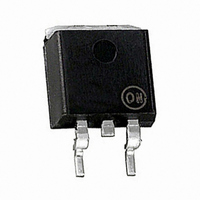CS8321YDPR3 ON Semiconductor, CS8321YDPR3 Datasheet - Page 4

CS8321YDPR3
Manufacturer Part Number
CS8321YDPR3
Description
IC REG LDO LIN 150MA 5V D2PAK-3
Manufacturer
ON Semiconductor
Datasheet
1.CS8321YDPR3.pdf
(6 pages)
Specifications of CS8321YDPR3
Regulator Topology
Positive Fixed
Voltage - Output
5V
Voltage - Input
6 ~ 26 V
Voltage - Dropout (typical)
0.3V @ 150mA
Number Of Regulators
1
Current - Output
150mA
Current - Limit (min)
175mA
Operating Temperature
-40°C ~ 125°C
Mounting Type
Surface Mount
Package / Case
TO-263-3, D²Pak (3 leads + Tab), TO-263AA
Lead Free Status / RoHS Status
Contains lead / RoHS non-compliant
Other names
CS8321YDPR3OS
recommended value and work towards a less expensive
alternative part.
capacitor of the recommended value in an environmental
chamber at the lowest specified operating temperature and
monitor the outputs with an oscilloscope. A decade box
connected in series with the capacitor will simulate the
higher ESR of an aluminum capacitor. Leave the decade box
outside the chamber, the small resistance added by the
longer leads is negligible.
increase the load current slowly from zero to full load while
observing the output for any oscillations. If no oscillations
are observed, the capacitor is large enough to ensure a stable
design under steady state conditions.
the decade box and vary the load current until oscillations
appear. Record the values of load current and ESR that cause
the greatest oscillation. This represents the worst case load
conditions for the regulator at low temperature.
3 and vary the input voltage until the oscillations increase.
This point represents the worst case input voltage
conditions.
with the next smaller valued capacitor. A smaller capacitor
will usually cost less and occupy less board space. If the
output oscillates within the range of expected operating
conditions, repeat steps 3 and 4 with the next larger standard
capacitor value.
various loads at several frequencies to simulate its real
working environment. Vary the ESR to reduce ringing.
operating temperature. Vary the load current as instructed in
step 5 to test for any oscillations.
ESR is found, a safety factor should be added to allow for the
tolerance of the capacitor and any variations in regulator
performance. Most good quality aluminum electrolytic
capacitors have a tolerance of ±20% so the minimum value
found should be increased by at least 50% to allow for this
tolerance plus the variation which will occur at low
temperatures. The ESR of the capacitor should be less than
50% of the maximum allowable ESR found in step 3 above.
regulator (Figure 5) is:
where:
Step 1: Place the completed circuit with a tantalum
Step 2: With the input voltage at its maximum value,
Step 3: Increase the ESR of the capacitor from zero using
Step 4: Maintain the worst case load conditions set in step
Step 5: If the capacitor is adequate, repeat steps 3 and 4
Step 6: Test the load transient response by switching in
Step 7: Raise the temperature to the highest specified
Once the minimum capacitor value with the maximum
The maximum power dissipation for a single output
P D(max) + ( V IN(max) * V OUT(min) ) I OUT(max)
IN A SINGLE OUTPUT LINEAR REGULATOR
CALCULATING POWER DISSIPATION
) V IN(max) I Q
http://onsemi.com
(1)
CS8321
4
permissible value of R
package section of the data sheet. Those packages with
R
the die temperature below 150°C.
dissipate the heat generated by the IC, and an external
heatsink will be required.
package to improve the flow of heat away from the IC and
into the surrounding air.
outside environment will have a thermal resistance. Like
series electrical resistances, these resistances are summed to
determine the value of R
where:
R
functions of the package type, heatsink and the interface
between them. These values appear in heatsink data sheets
of heatsink manufacturers.
qJA
qJA
V
V
V
I
I
Once the value of P
The value of R
In some cases, none of the packages will be sufficient to
A heatsink effectively increases the surface area of the
Each material in the heat flow path between the IC and the
R
R
R
R
OUT(max)
Q
IN
qJC
qCS
qSA
qJC
IN(max)
OUT(min)
application, and
I
’s less than the calculated value in equation 2 will keep
, it too is a function of package type. R
OUT(max)
is the quiescent current the regulator consumes at
Figure 5. Single Output Regulator with Key
= the junctionïtoïcase thermal resistance,
appears in the package section of the data sheet. Like
= the caseïtoïheatsink thermal resistance, and
= the heatsinkïtoïambient thermal resistance.
Performance Parameters Labeled
I
R qJA + R qJC ) R qCS ) R qSA
is the maximum input voltage,
IN
is the minimum output voltage,
is the maximum output current for the
.
qJA
R qJA + 150°C * T A
can then be compared with those in the
qJA
HEATSINKS
D(max)
qJA
CS8321
can be calculated:
:
P D
is known, the maximum
I
Q
qCS
I
OUT
and R
qSA
V
OUT
are
(2)
(3)





